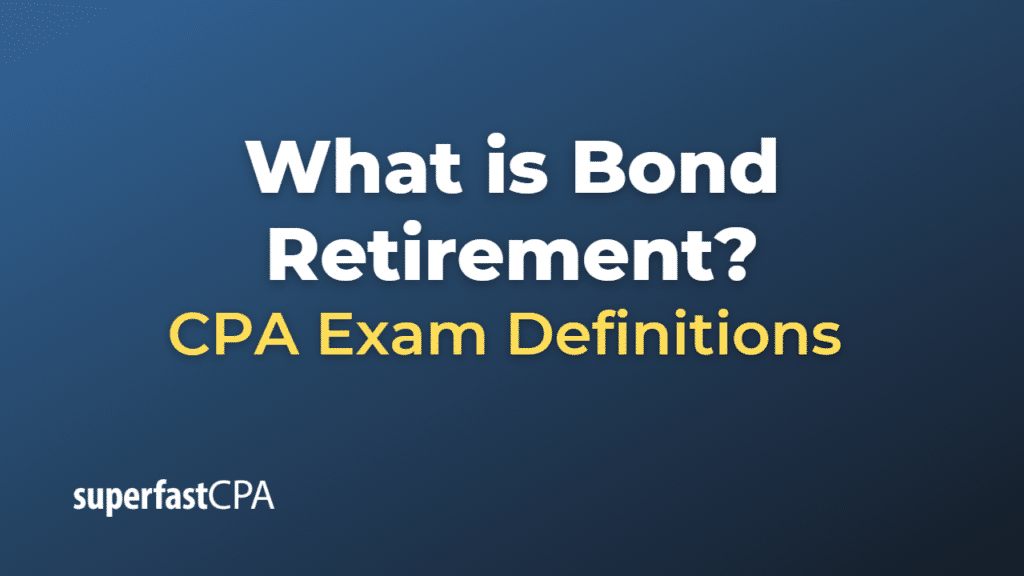Bond Retirement
Bond retirement refers to the process of repaying the principal amount of a bond issue to the bondholders when the bond reaches its maturity date or is called by the issuer before maturity. Essentially, bond retirement is the final stage of a bond’s life cycle, during which the issuer fulfills its obligation to the bondholders by repaying the borrowed funds.
There are several ways a bond can be retired:
- Maturity: When a bond reaches its maturity date, the issuer repays the principal amount (also known as the face or par value) to the bondholders, and the bond ceases to exist. The bondholders no longer receive interest payments, as the issuer’s debt obligation is considered fulfilled.
- Call (redemption): Some bonds have a call provision that allows the issuer to redeem the bonds before their maturity date. If the issuer decides to call the bonds, it must pay the bondholders the principal amount along with any accrued interest and, in some cases, a call premium. This can be done to take advantage of lower interest rates, reduce debt, or alter the company’s capital structure.
- Sinking fund: A sinking fund is a separate account established by the issuer to gradually retire bonds over time. Periodic payments are made into the sinking fund, which is then used to purchase and retire a portion of the bonds in the open market or through a lottery system. This method helps the issuer manage its debt obligations and reduces the risk of default.
- Refunding: As mentioned earlier, bond refunding involves issuing new bonds to replace existing bonds, typically at a lower interest rate. The proceeds from the new bond issuance are used to retire the outstanding bonds, either immediately in the case of current refunding or at a later date for advance refunding.
Bond retirement is a crucial aspect of debt management for issuers, as it demonstrates their ability to fulfill their obligations to bondholders and maintain a good credit reputation in the market. Properly managing bond retirement can help issuers maintain their credit rating and reduce borrowing costs in the future.
Example of Bond Retirement
Let’s consider a hypothetical example to illustrate the concept of bond retirement.
Suppose that five years ago, a company named GreenTech Corp. issued 5-year corporate bonds with the following details:
- Face value: $1,000 per bond
- Coupon rate: 4% per annum, paid semiannually
- Maturity date: 5 years from the date of issuance
- Total bonds issued: 10,000 bonds
As the bonds are reaching their maturity date, GreenTech Corp. must retire the bonds by repaying the principal amount to the bondholders. Here’s how the bond retirement process works in this example:
- On the maturity date, GreenTech Corp. repays the bondholders the principal amount of $1,000 per bond. In total, the company will repay $10,000,000 (10,000 bonds × $1,000 face value) to the bondholders.
- Along with the principal repayment, GreenTech Corp. also makes the final interest payment to the bondholders. As the bonds have a 4% coupon rate, the semiannual interest payment is $20 ($1,000 face value × 4% coupon rate ÷ 2). In total, the company will pay $200,000 in interest (10,000 bonds × $20) on the maturity date.
- Once the principal and interest payments have been made, GreenTech Corp.’s obligation to the bondholders is fulfilled, and the bonds are considered retired. The bondholders no longer receive interest payments, and GreenTech Corp. no longer has the bonds on its balance sheet as a liability.
In this example, GreenTech Corp. successfully retires its bonds at maturity by repaying the principal amount and making the final interest payment to the bondholders, demonstrating its ability to fulfill its debt obligations and maintain its credit reputation in the market.












